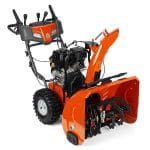There are several options for Autumn. One option is to cut the grass and then let it go dormant. This gives a brown, bare lawn that will return in Spring, but provides shelter and food for many animals who would perish during harsh winters without such cover. Another option is to use a mulch to create a flowerbed border around your yard while cutting the rest of the lawn to provide food for wildlife and insulation over winter. A third option is to plant native species like goldenrod or Joe Pye weed around your yard while allowing the rest of the lawn to remain intact; this does not provide much shelter but attracts helpful pollinators which aid in your flowers’ next season’s growth while providing fall colour and seeds through birds.
Mow your lawn before leaves start to fall
The leaves will not only look unpleasant on the lawn, but they also have a tendency to get stuck in the blades of your mower.
Check out ???? gas-powered leaf blowers for another way to clear off grass quickly. If using a manual rake isn’t cutting it for you, consider an electric or cordless variety.
De-thatch your lawn before fall arrives. The dethatching process can be risky if done during this time of year because most people are still adding fertilizer and other chemicals to their yards during this period -even though they shouldn’t – but it is important that you begin preparing for colder weather by getting rid of any thatch buildup on the surface of your grass before autumn begins.
Start by removing the leaves from your lawn
Don’t let leaves accumulate on the lawn. Remove them, don’t leave them there to rot.
Leaves can change soil pH. Grass doesn’t like acidic soils, so if you have a high proportion of leaves in the soil it’s going to make your lawn more acidic. This makes it harder for grassroots to get at nutrients in the soil and slows down all the other good stuff that goes on in your soil – take-up of water, nutrient cycling etc. The result is weak grass plants that are more susceptible to pests and diseases. If possible compost or chip up fallen leaves rather than putting them into your green bin or sending them off with your normal waste collection service!
Grasses that stay green all year long
 One way to make the most of your lawn is by planting grasses that stay green all year long, such as rye or bluegrass. These are not native species but can look just as nice as having a patch of dandelion flowers in the yard, especially if you plan to mow at regular intervals.
One way to make the most of your lawn is by planting grasses that stay green all year long, such as rye or bluegrass. These are not native species but can look just as nice as having a patch of dandelion flowers in the yard, especially if you plan to mow at regular intervals.
Another benefit of planting these types of plants is nesting opportunities, providing shelter & food for birds during the winter months when they cannot find it elsewhere.
Mulch flowerbeds with colorful leaves and plant some shade-loving evergreens on sunny slopes.
Plant trees around the perimeter of your yard for a natural look and feel
One of the most beneficial things you can do to your lawn is to plant deciduous trees on the edge of it. Doing so will help water retention in the soil, add a natural look feel, and provide shade from harsh summer climates.
You may be interested to read before winter: Best Snow Blowers 2021. Shopping Guide & Reviews., Lawn Care Tips For Before Winter






